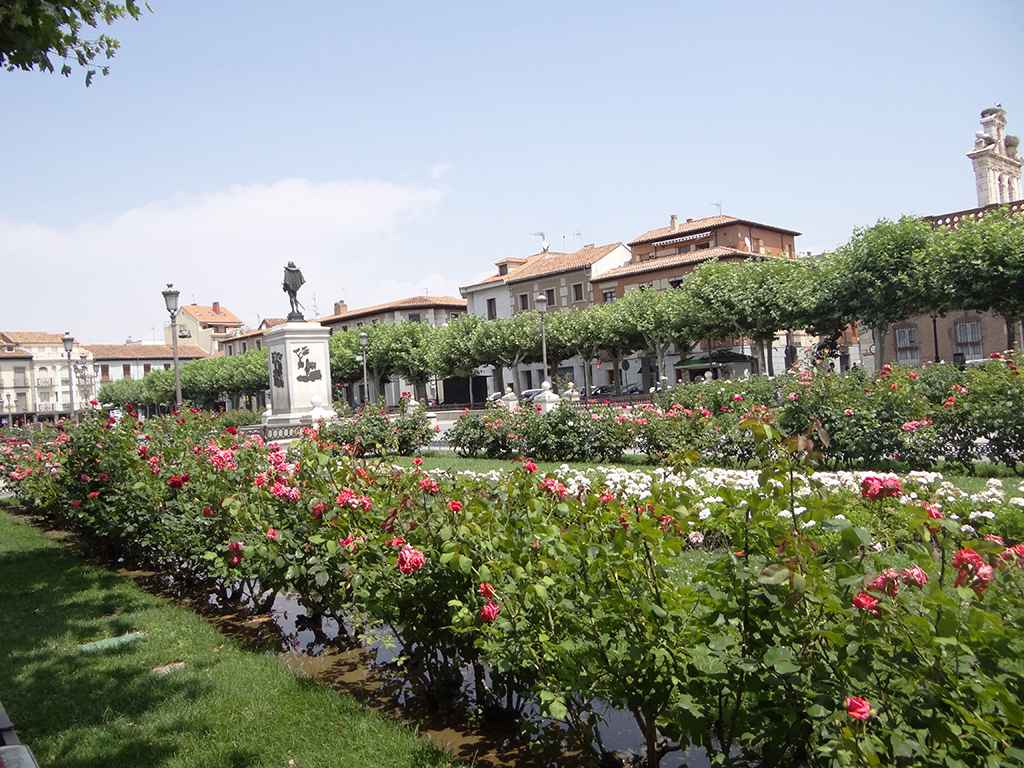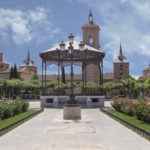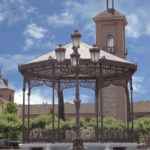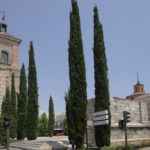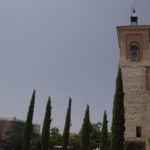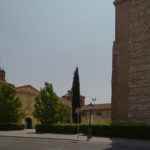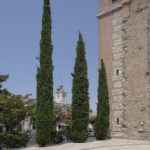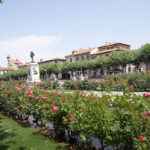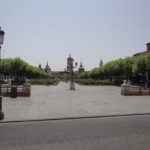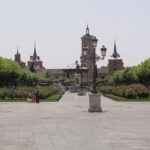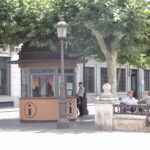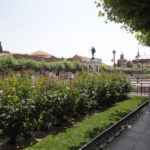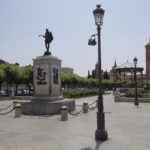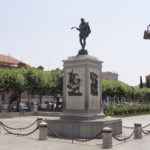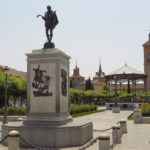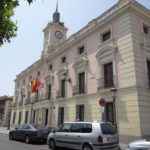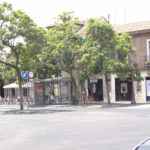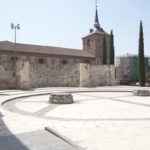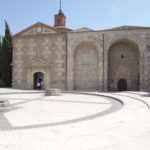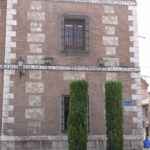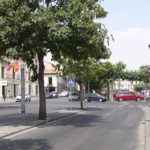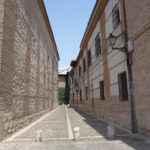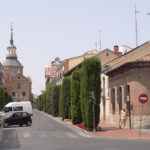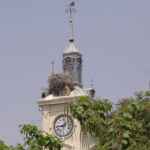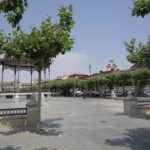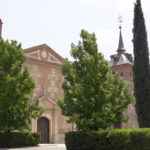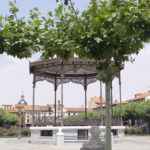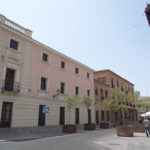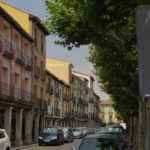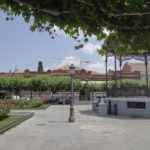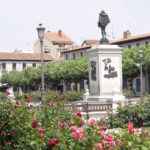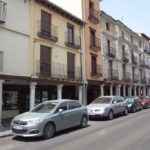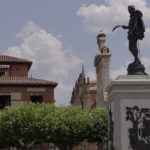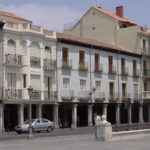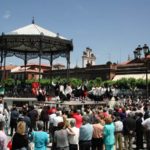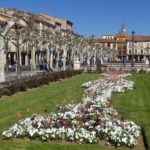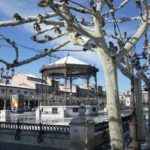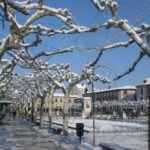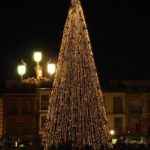Este texto también está disponible en español
At the very heart of Alcalá de Henares’ rich historical center, Plaza de Cervantes is, for both visitors and neighbors, the city’s core and main meeting point, where they can enjoy long promenades lined with trees and the impressive, very well maintained gardens that surround Miguel de Cervantes statue.
Alcalá de Henares has been listed as a World Heritage City—the only one within the Community of Madrid and one among the nine through Spain—thanks to its historical center, where Plaza de Cervantes stands out as the central jewel. The rectangular square is fortified by low height buildings that, along with its quiet aspect, provide a cozy charm with sluggish traffic. On weekends, the street becomes a pedestrian mall, where passers-by wonder around its perimeter completely covered by a canopy of trees, or visit one of many interesting places situated within it.
Whenever the weather is right, Plaza de Cervantes get crowded of passers-by trying to relax and unwind, and have a nice chat, losing all sense of time, especially as the light fades. Hence, there are plenty of seats and kiosks surrounded of tables where enjoy a drink or an ice-cream.
Plaza de Cervantes dates back from thirteenth century when it hold a weekly marketplace as well as any other important event celebrated in the city, including bullfighting—until the nineteenth century. Nowadays, it still holds lots of local festivities, such as contests between different city festivity groups or peñas, dances and concerts, every year in August.
The Cervantes’ statue
The geographical and social center of Plaza de Cervantes holds a bronze statue of Miguel de Cervantes, meeting point par excellence for city inhabitants and visitors alike. Erected in 1879 by Carlo Nicoli and illustrated with modern bas-relief in its pedestal by José Noja, the statue represents several scenes of the masterpiece of the author born in Alcalá a few meters from Plaza de Cervantes.
Designed by the architect Martín Pastells and built up in the Lebrero’s foundry of Madrid, in 1898, a splendid music pavilion stands near that monument. Right opposite, you will find the City Hall or City Council, from where you may start a tour visiting all the surrounding buildings that confer the square the historical and social dimension that characterizes the always throbbing heart of Alcalá.
The City Council
In Plaza de Cervantes, the current City Council, head office of local powers, was in the old days the Convento the Agonizantes. Nevertheless, many councillorships or local government delegations have their head in buildings throughout all Alcalá.
The building was turned into City Council in the nineteenth century. In the first floor, or noble, the Salón de Plenos—dating back from the same nineteenth century—and the Junta del Gobierno hall stand up. The latter room, houses the Cervantes’ baptismal certificate and the Complutensian Polyglot Bible busted by Cardinal Cisneros in the fifteenth century.
The Corral de Comedias
One of the two city’s greatest theaters, the Corral de Comedias has previously been used both as a romantic theatre and as a cinema. Yet, as restorations were undertaken, it emerged what is considered today as the oldest theatre of Europe still functioning—since it was thought up in 1601 by the carpenter Francisco Sánchez. It was built upon the scheme of a classical comedy theatre with balcony, stands and gods—the space addressed to women who was separated from men.
The Santa María Tower
Going from the square to calle Colegios—where precisely several university colleges are placed—you will run into what it seems a church, with a small square in front of and next to an impressive solitary tower. This is the old church of Santa María la Mayor, set fire during the Civil War, from which it just remains the Oidor and Antezana chapels, and its tower. You can also see, in Oidor Chapel, the font where Miguel de Cervantes was baptized on 9 of October of 1547.
The tower restoration was finished in 2009, and then, it is now possible to go up the 109 steps of the spiral staircase and obtain one of the best views of both the Plaza de Cervantes, and the hole city. A place which certainly deserves the visit.
The Círculo de Contribuyentes
Next to the Oidor Chapel, the Municipal Tourism Office and the Círculo de Contribuyentes building with its great access staircase are founded. This building belongs to the Condueños Society, founded by a group of Alcalá citizens in 1851, with a totally unselfish and filantropic aim: saving the University buildings that were going to be auctioned and take out of the city stone by stone. They contributed with 80.000 reales (old Spanish currency) and achieve the buildings to stay safe and sound until today. Nowadays, the Círculo de Contribuyentes holds the restaurant El Casino,—one of the most well-known of Alcalá de Henares—,where you can enjoy a good traditional and vanguard, high quality food.
Additional information:
- Concejalía de Turismo del Ayuntamiento de Alcalá de Henares
- Guía de Alcalá de Henares de la Comunidad de Madrid
- Epistemowikia
- Centro Virtual Cervantes
The tourist says:
Useful information:
- Address: Plaza de Cervantes.
Access from Madrid
- Renfe Cercanías railroads C-1, C-2 and C7A.
- Bus nº 223 (departure from Avenida de América Interchanger).
Image gallery:
On video:
Where is it
Sigue disfrutando de Dream Alcalá:
- Telegram: Recibe nuestras noticias y contenido exclusivo (clic aquí).
- Newsletter: Recibe cada tarde un correo con nuestras últimas noticias (clic aquí).
- YouTube: Suscríbete para ver nuestros mejores vídeos (clic aquí).
 Sé tú el periodista: envíanos tus fotos o noticias a través de Telegram.
Sé tú el periodista: envíanos tus fotos o noticias a través de Telegram.

